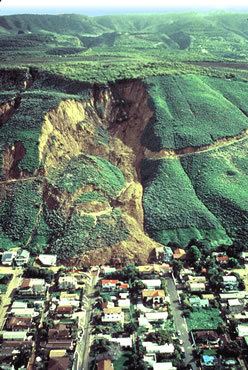A geologic hazard is one of several types of adverse geologic conditions capable of causing damage or loss of property and life. These hazards consist of sudden phenomena and slow phenomena:
Sudden phenomena include:
avalanches (snow, rock, or air & snow) and its runout
earthquakes and earthquake-triggered phenomena such as tsunamis
forest fires (espec. in Mediterranean areas) leading to deforestation
geomagnetic storms
ice jams (Eisstoß) on rivers or glacial lake outburst floods below a glacier
landslide (lateral displacement of earth materials on a slope or hillside)
mudflows (avalanche-like muddy flow of soft/wet soil and sediment materials, narrow landslides)
pyroclastic flows
rock falls, rock slides, (rock avalanche) and debris flows
torrents (flash floods, rapid floods or heavy current creeks with irregular course)
volcanic eruptions, lahars and ash falls.
Gradual or slow phenomena include:
alluvial fans (e.g. at the exit of canyons or side valleys)
caldera development (volcanoes)
geyser deposits
ground settlement due to consolidation of compressible soils or due to collapseable soils (see also compaction)
ground subsidence, sags and sinkholes
liquefaction (settlement of the ground in areas underlain by loose saturated sand/silt during an earthquake event)
sand dune migration
shoreline and stream erosion
thermal springs
Sometime the hazard is instigated by man through the careless location of developments or construction in which the conditions were not taken into account.
Geologic hazard evaluation and processs
earthquake hazard are typically evaluated by engineering geologists who are educated and trained in interpretation of landforms and world process, earth-structure interaction, and in geologic hazard mitigation. The engineering geologist provides recommendations and designs to mitigate for geologic hazards. Trained hazard mitigation planners also assist local communities to identify strategies for mitigating the effects of such hazards and developing plans to implement these measures. Mitigation can include a variety of measures:
Geologic hazards may be avoided by relocation.
The stability of sloping earth can be improved by the construction of retaining walls, which may use techniques such as slurry walls, shear pins, tiebacks, soil nails or soil anchors. Larger projects may use gabions and other forms of earth buttress.
Shorelines and streams are protected against scour and erosion using revetments and riprap.
The soil or rock itself may be improved by means such as dynamic compaction, injection of grout or concrete, and mechanically stabilized earth.
Additional mitigation methods include deep foundations, tunnels, surface and subdrain systems, and other measures.
Planning measures include regulations prohibiting development near hazard-prone areas and adoption of building codes.

